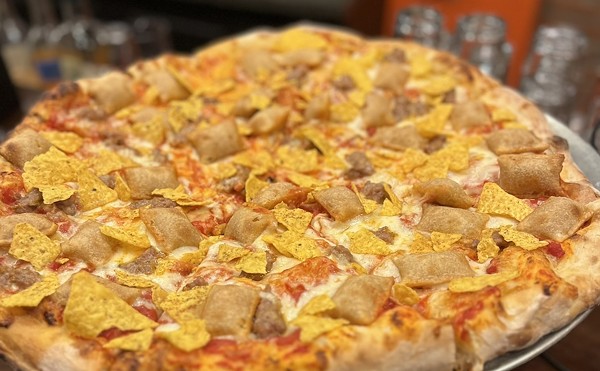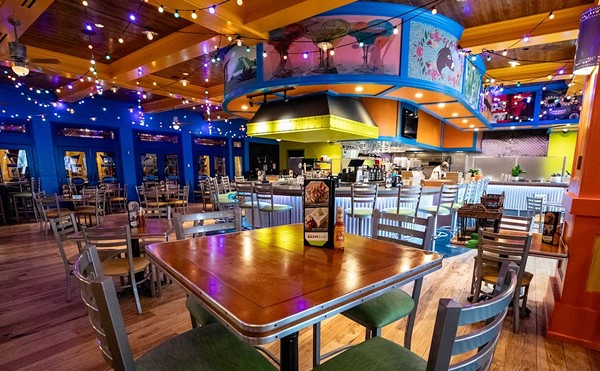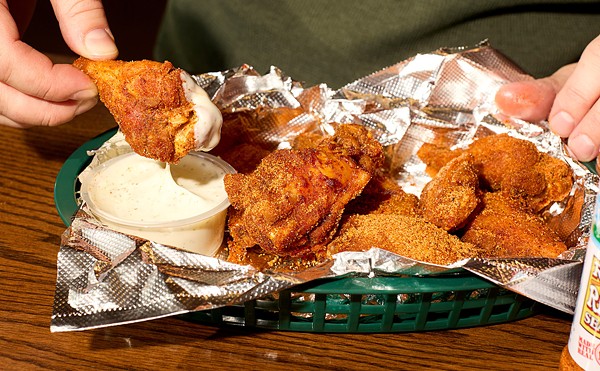Hama-san has been spending most of his time lately at the second location of Sansui, which took over the old Ted & Teiko's space on Manchester Road near Sappington Road about six months ago. The refurbished space is bright and meticulously arranged, with a giant photograph of Hama-san and legendary French chef Paul Bocuse greeting diners in the entryway and providing a hint that the evening might provide more than the expected sushi, tempura and teriyaki.
Those items are all on the menu, but so is a command performance by the chef called omakase, which translates as "Trust me." You pledge 40, 60 or 80 dollars per person, and then you sit back and enjoy the ride. It's the Japanese equivalent of a chef's tasting menu -- or, at the high end, the menu de degustation at a French restaurant, a term that sounds as lusty as it usually ends up being.
We test-drove the Sansui omakase with the mid-sized model, at the conclusion of which we were so full and so satisfied that we marveled at those who would take on the highest challenge. First up was something perhaps best described as a "crunchfest salad": artfully arranged (as was every dish throughout the evening) slices of squid dotted with bright-orange fish roe, along with a nest of long shreds of daikon radish, razor-thin slices of miniature cucumber, a bouquet of kaiware (radish sprouts) and the puckering flavor of the umeshiso leaf (edible but also there as a decorative accessory). The Italians originated the concept of al dente, the resistance to the teeth felt when one bites into pasta, but this creation illustrated the pleasures of varying degrees of al dente: the collapse of the tiny stalk of the sprout, the mild crunch of the cuke, the firmer crunch of the radish, the raw-mushroom texture of the squid and, finally, the bubble-wrap pop of the fish eggs.
Next up, a sashimi plate called usuzukuri: very thin slices of hirame (flounder), arranged in an outward spiral on a circular plate, with a rosebud-shaped piece at the center and finely chopped scallions as an accent. The dipping sauce was ponzu, a citrus-enhanced soy sauce that contains scallions and radishes reduced to a paste; the ubiquitous shredded daikon and kaiware were again used as edible decorations, along with a lemon slice whose peel had been partially separated and carved into a whimsical leaping stag.
Our waitress announced the next course as "clam with sea urchin," but on closer inspection, both the two shells -- served on rectangular, polished stoneware on a bed of sea salt -- and the mollusks themselves appeared and tasted like scallops, draped as they were with umber-colored slabs of uni, the densely sea-flavored roe of the sea urchin. More seafood followed, but at the other end of the rich-flavor scale: a small, lightly fried bluefish, whole but headless, trimmed such that chopsticks could easily remove about eight mild, bite-size morsels.
The focus then shifted to a luxurious preparation of duck -- six slices of breast, somewhere between medium-rare and medium. Its texture resembled a good pork roast, but the full flavor and crispy skin left on the edges left no doubt what it was. This was served with a light soy dressing and, more interestingly, a collection of baby spring greens that added a slight nutty finish. Then it was back to seafood again, a slice of cod brushed with a light, sweetened soy sauce, with a relatively small conch inside its spiral shell, cooked in the same sweet liquid, on the side and a red-tipped stalk that looked like a drunken, elfin white asparagus but was in fact a pickled tip of baby ginger.
We weren't finished yet. Next arrived a lidded soup bowl with a smaller bowl on the side. Inside the main bowl was a poached fillet of sea bass, served in an herbed citrus broth wrapped around a small portion of green soba noodles. If you're a sushi lover, Hama-san saves the best for last (or at least the last course before dessert): The finale was a five-shade spectrum of tuna, including o-toro, the prized "fatty" tuna; a translucent, ruby-colored slice; chu-toro, a shade in between the two; zuke, a piece of marinated tuna topped with a tiny ribbon of scallion; and the surprise of the plate, shiro (white) tuna, with much the same texture as the deep-maroon version but pure cream-white in color. As an added touch, the wasabi was grated and fresh rather than the reconstituted lump of green clay that comes out of a can or tube. (Hama-san was vague about his source; an article in Saveur magazine a couple of years ago noted that real wasabi is all but unknown in the U.S. and that even the pasty stuff very likely started life as good old American horseradish.) Wherever it came from, it was crunchy and more subtly flavored than the more common alternative.
And in keeping with the tone of the rest of the meal, the dessert was much more than an afterthought -- green ice cream, tea-tinged but not as astringent as some of the "green tea" ice cream popular in Japanese restaurants, wrapped in a paper-thin green crepe and topped with a warm berry compote, with three ripe, juicy, perfect raspberries arranged on the side in a chocolate-veined pool of vanilla cream.
We left relatively astonished at what we had just experienced. We recognized, though, that neither the sometimes exotic courses nor the cost would be appealing to everyone, so we limited our other visit to the everyday à la carte choices on the menu and found this equally appealing. Negima -- paper-thin beef rolled around scallions in a rich teriyaki reduction -- and three well-trimmed lamb chops with ponzu sauce were our appetizers, with sole nitsuke and a sashimi tray for entrees. The sole was whole, brushed and cooked with ginger and a sweet soy sauce but made dark and bumpy on the outside by the preparation, appearing almost like a plate of barbecued ribs. It was quite tender within and very easily filleted with chopsticks. The sashimi plate, ordered in the larger, "deluxe" version, included three slices each of giant clam, flounder, salmon, yellowtail, tuna, squid and octopus and was nicely devoid of those annoying serrated green-plastic decorations, instead garnished with a whole umeshiso leaf and other raw vegetables.
We also should note that Hama-san -- a graduate of the Japan Culinary School in Osaka and formerly on the staff of the Ritz-Carlton, where the Bocuse encounter took place -- also has a sushi chef, David Hong, to create some of these visual delights.
There's what appears to be a rack of wines lining the back wall, but we never saw a wine list. Instead we opted for a four-shot tray of Momokawa cold sakes, which included a choice both of the premium selections and of raspberry, Asian pear, hazelnut and yuzu, a Japanese citrus fruit.
Our service was exceptionally cordial, but the omakase would be improved if Hama-san took the time to train his staff to present it better. First, we got a quizzical look when we tried to order it; more to the point, our waitress brought some of the dishes without any explanation beyond "poached fish," and then she wasn't exactly sure what kind of fish it was. This didn't detract from the overall experience, but a sentence or so explaining what each dish is and why it's so wonderful would truly make the omakase untouchable in terms of a local eating adventure.





